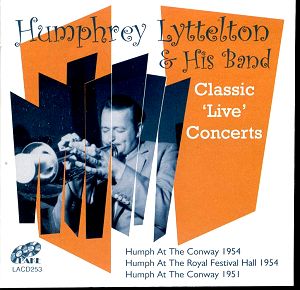Texas Moaner
Coal Black Shine
Last Smile Blues
Elephant Stomp
Wally Plays The Blues
My Bucket's Got A Hole In It
I Double Dare You
That's The Blues, Old Man
Feline Stomp
St. James' Infirmary Blues
Memphis Shake
Mo Pas Lemmé Ça
Introductory Blues
High Society
South Side Stomp
Basin Street Blues
I Wish I Could Shimmy Like My Sister Kate
Trog's Blues
The Onions
When The Saints Go Marching In
I Love Paris
See See Rider
The Old Grey Mare
New Orleans Stomp
Out Of The Gallion
The Onions
Jelly Roll Blues
Red For Piccadilly
Steppin' On The Blues
Randolph Turpin Stomp
Nothin' But Trouble
The Next Number
Big Cat, Little Cat
Canal Street Blues
Mezz's Tune
Jelly Bean Blues
Ace In The Hole
Coffee Grinder
Mainly Traditional
Oh, Dad!
The 1954 Conway Hall concert
is a Humph classic, the product of controlled
ebullience and vibrant musicianship allied
to clever tune selection and a soupçon
of crowd participation. And then there are
Lyttelton’s droll song announcements, which
can do no harm. The result is a twelve song
recital, drivingly performed and of lasting
value. Bruce Turner was on board at the time
and with Johnny Parker he takes the honours
in Coal Black Shine – though the powerful
jet of Humph’s trumpet and Wally Fawkes’s
slightly off-mike polyphony are richly enjoyable
in their own right. The blues tracks have
particular strength. For some reason Humph
always referred to Ida Cox’s Last Mile
Blues as the less probable Last Smile
Blues – unless he knew something we don’t,
as the song is always credited to the former
title. Fawkes is again prominent and superb
and the Conway Hall "ashtray" –
a mute – can be heard in Lyttelton’s solo.
My Bucket's Got A Hole In It generates
a righteous groove with the band locked into
a powerfully rhythmic direction. There’s a
freedom and a command in this live concert
that still resonates over fifty years on.
The other Conway Hall concert
dates from 1951. It has a Lyttelton-Fawkes
front line – Humph plays clarinet on a couple
of tracks to add variety. His own tune Red
for Piccadilly is deep in New Orleans
revivalist territory; in fact the two sound
as close to Bunk Johnson and George Lewis
as I’ve ever heard them and as close as I
suspect they ever came to that sound. The
rhythm section is much heavier than is ideal
– and successive groups lightened that aspect
of the Lyttelton band sound to considerable
advantage. There’s a Wagnerian side to the
’51 band that fortunately didn’t long survive.
But there’s some first class boogie from Johnny
Parker on Big Cat, Little Cat and finally
a more relaxed rhythmic sound emerges in the
front line’s playing of The Next Number.
The third live concert comes
from the Royal Festival Hall in 1954. Trombonist
John Picard is on board – young he may have
been but his confidence and strength are palpable.
He takes a laid back, lazily phrased solo
on Basin Street Blues that may have
had Teagarden as a rhythmic role model but
sounds individual, tonally and expressively.
The band mines hard driving black Chicago
style for South Side Stomp – Jimmy
Blythe’s influence pervasive here - and the
barrelhouse atmosphere is powerful indeed.
As a bonus there are six
studio tracks. The most interesting have George
Chisholm on hand, and his presence is a fillip.
If you’re a Lyttelton collector
who has somehow neglected to add the ’54 Conway
Hall concert to your collection here’s your
chance – you’ll get two other live concerts
and some studio tracks as well. The two CDs
are priced as one – a further inducement to
purchase.
Jonathan Woolf
